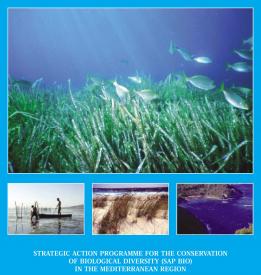Search
Consultation meeting about a SAPBIO revision process (Tunis, 4-5 April 2011)
Consultation meeting - following the 10th Conference of Parties to the CBD, Tunis, 4-5 April 2011
On April the 4th and 5th 2011, RAC/SPA convened a consultation meeting, bringing together several partners acting in the field of Mediterranean biodiversity conservation, to discuss future orientations after the Nagoya meeting and the decisions that have resulted from.
Around the conference table, were represented: RAC/SPA scientific staff, the Coordinating Unit for the Mediterranean Action Plan (UNEP/MAP), the Agreement for the Conservation of Cetaceans in the Black Sea, Mediterranean Sea and Contiguous Atlantic Area (ACCOBAMS), the General Fisheries Commission for the Mediterranean (GFCM), the Conservatoire du Littoral, IUCN Centre for Mediterranean Cooperation - IUCN Med, the managers' network of Marine Protected Areas in the Mediterranean (MedPan), WWF - MedPo and several consultants.
The focus of this meeting was the new recommendations out of the tenth meeting of the Conference of Parties to the Convention on Biological Diversity (COP10) held in Nagoya last October. A note was made in advance and discussed at this meeting to give a vision on the future directions of activities of RAC/SPA and its partners in light of new objectives.
Participants discussed the best way to align the activities of RAC/SPA to these new priorities, in addition, through a revision of the Strategic Action Programme for the Conservation of Biodiversity in the Mediterranean (SAP BIO), but also by embedding direct activities with the countries to manage to reach these new targets. However, COP10 was not dealing specially with the Mediterranean and that closed environment which is a bit special, and it was therefore necessary to review the various new outgoing objectives of this COP for the best fit for that special geographical space.
All countries bordering the Mediterranean are Parties to the Convention on Biological Diversity (CBD), and are therefore affected by the implementation of these new targets. In order to better supervise and assist them in achieving these new goals it is then good to update the SAP BIO with the various decisions of the CBD.
From the 47 decisions adopted by the CBD COP10, 20 are considered particularly relevant for the conservation of marine biodiversity in the Mediterranean coasts:
- X/1. Access to Genetic Resources and the Fair and Equitable Sharing of Benefits Arising from their utilization.
- X/2. The Strategic Plan for Biodiversity 2011-2020 and the Aichi Biodiversity Targets.
- X/3. Strategy for resource mobilization in support of the achievement of the Convention’s three objectives.
- X/4. Third edition of the Global Biodiversity Outlook: implications for the future implementation of the Convention.
- X/5. Implementation of the Convention and the Strategic Plan.
- X/6. Integration of biodiversity into poverty eradication and development.
- X/7. Examination of the outcome-oriented goals and targets (and associated indicators) and consideration of their possible adjustment for the period beyond 2010.
- X/8. United Nations Decade on Biodiversity 2011-2020.
- X/11. Science-policy interface on biodiversity, ecosystem services and human well-being and consideration of the outcome of the intergovernmental meetings.
- X/18. Communication, education and public awareness and the International Year of Biodiversity.
- X/20. Cooperation with other conventions and international organizations and initiatives.
- X/21. Business engagement.
- X/22. Plan of Action on Subnational Governments, Cities and Other Local Authorities for Biodiversity.
- X/23. Multi-Year Plan of Action for South-South Cooperation on Biodiversity for Development.
- X/29. Marine and coastal biodiversity.
- X/30. Mountain biological diversity.
- X/31. Protected areas.
- X/32. Sustainable use of biodiversity.
- X/33. Biodiversity and climate change.
- X/38. Invasive alien species.
- X/39. Global Taxonomy Initiative.
More specifically, two of these decisions are not addressed by the SAP BIO, it’s about the issue of access to genetic resources and equitable sharing of benefits arising from their use, and the strategic plan 2011-2020 CBD or strategic plan (SP) in Aichi.
A comparison of the SAP-BIO with five basic goals of the Strategic Plan Aichi which have been reviewed and discussed and will help prepare a draft on the guidelines and actions to implement at the Mediterranean level to better adapt to new trends set by the decisions of Nagoya.




Find Us On...